Disclosure
Commercial support for this program has been provided by Michael Foods.
Looking to sign up for our newsletter? Click here
Sign up for NewsletterSauces & Dressings
Baked Goods
Pastas
Sports Nutrition
Pet Foods
Learn about our team’s extensive capabilities and resources.
Get to Know UsEggs
Potatoes
French Toast
See the Story From Our Farm To Your Table

Michael Foods Online CE Course (1 hour CE)
Michael Foods, Inc. will maintain verification of your attendance. Please fill out the following information. Upon completion of this course, a certificate of completion will be available for download.
Commercial support for this program has been provided by Michael Foods.
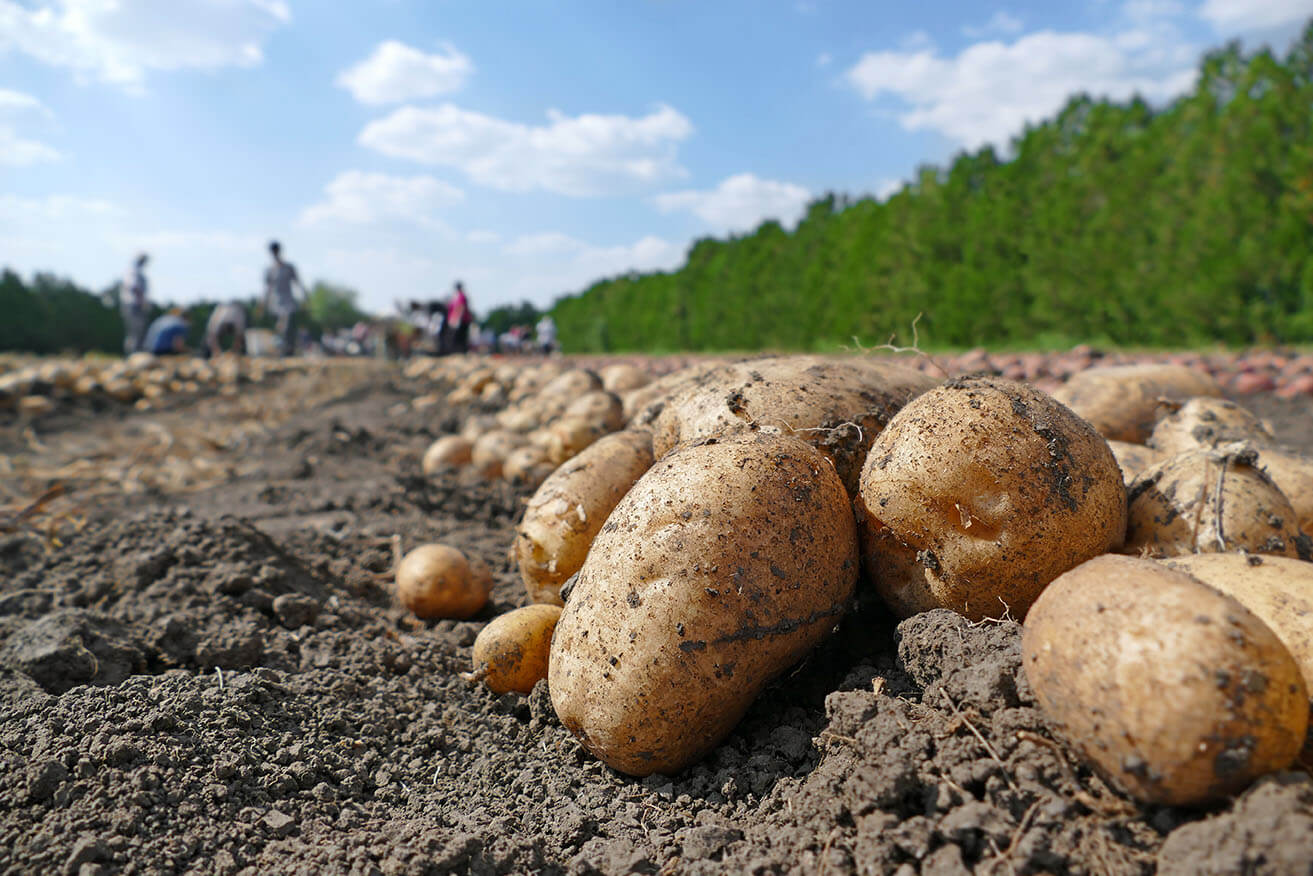
Potatoes are a perennial and versatile favorite. They are a cornerstone of growing demand for comfort food, breakfast-all-day, enticing bowls, and grab’n’go fare. This course examines the nutritional benefits of potatoes, consumer sentiment, culinary concepts, and foodservice menu trends that help an operator achieve high levels of success with economical ingredients.

Upon completion of this course, you will be able to:

Potatoes are “the most commonly consumed vegetable in the United States,” according to WebMD (2020). The average American consumes 49.2 pounds every year, they add.
A survey of food order data from DoorDash places potato ingredients in two of the top five most-ordered foods (Foodservice Director magazine, Jun 1, 2022):
Potatoes pervade foodservice menus across segments, as noted by Datassential figures reported for Potatoes USA (2021). They’re on the menu in:
Among consumers, 76% report they are eating more potatoes as of 2022 (Potatoes USA, 2022). Potatoes are Americans’ favorite side dish when eating out (Potatoes USA, 2022). “Any potato option” ranks as the number-one side dish both for dining in and takeout.
The Foodservice Patron Study, based on a survey of 1,500 foodservice customers and Datassential findings, reported that some form of potatoes is the second most common offering on a foodservice menu, after beef (Potatoes USA, 2022). Their findings also indicated that customers would spend more for a meal that included potatoes because “they believe potatoes benefit their dining experience and satisfy a particular craving”. The culinary style can match the venue, they add.
In foodservice, by daypart, the heaviest concentration is breakfast (77.8%), followed by dinner (65.2%) and lunch (38.9%). They’re also a major player in all-day menus (77.9%), according to Potatoes USA.
Top potato dishes on foodservice menus are:
Breakfast potatoes are “loved or liked by over 50% of U.S. consumers,” according to the industry trade group, Potatoes USA (accessed Feb. 24, 2024). They also note that more than half of foodservice operators believe the “largest opportunity for potatoes is breakfast”. Hash browns, a breakfast favorite, have seen an annual growth rate of 27.9% in overall sales (consumer plus foodservice), explains Tastewise (2022). Its most popular pairings are eggs, bacon, sausage, and cheese.
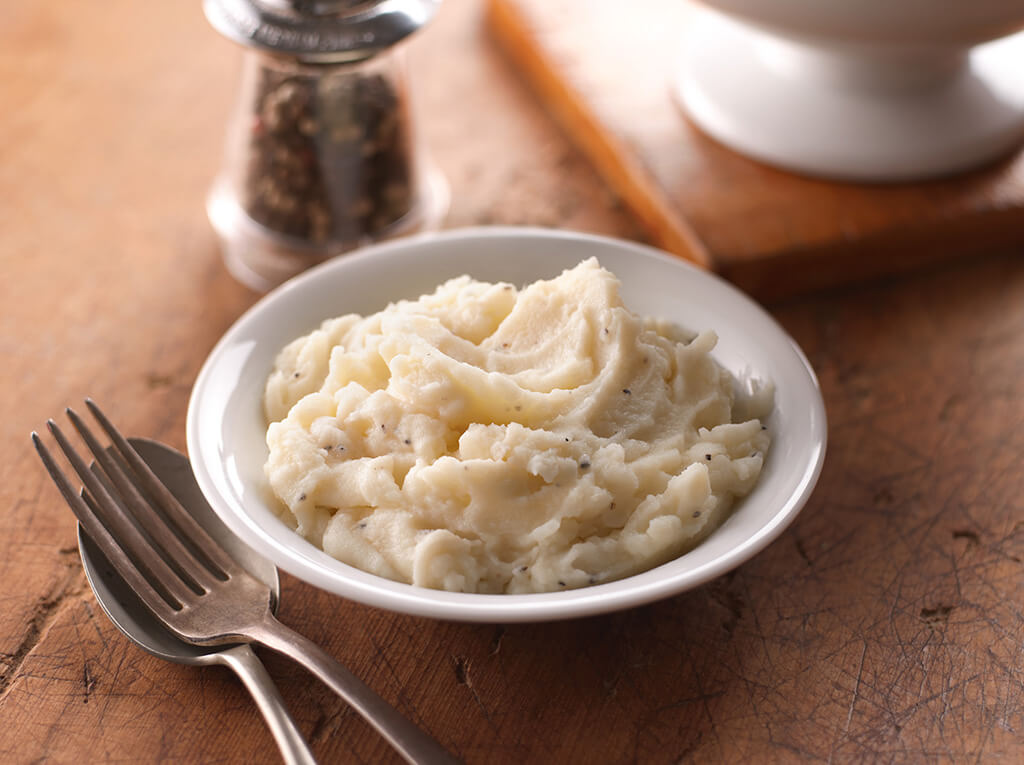
The pandemic lifestyle spurred a trend that’s always influenced eating choices: comfort food. Consumers enjoy the experience of eating something that triggers nostalgic good feelings. While which foods trigger good feelings depends on personal experience and preference, there are patterns.
For example, White (2020) states that “potatoes were the 1970s original ‘comfort food.’” Futterman (2021) lists top comfort foods as: grilled cheese, macaroni and cheese, mashed potatoes, pizza, and spaghetti and meatballs. SWNS Digital (2021) cites the most-consumed comfort foods (in order of popularity) as: pizza, hamburgers, ice cream, French fries, macaroni and cheese, potato chips, cookies, chocolate, cereal fried chicken, spaghetti and meatballs, mashed potatoes, bread, hot dogs, and pancakes.
At least 40% of consumers describe comfort food as something they ate growing up (Mondelez, 2022). Blake (July 2021) reports that consumers were eating comfort foods an average of five times per week during the pandemic—and the trend continues.
According to Mondelez (2022), “This trend for nostalgic eats and treats is showing no signs of slowing.” In fact, 7 out of 10 consumers say they are “’extremely or very likely’ to purchase a nostalgic food or beverage” (Mondelez, 2022).
In its 2022 Culinary Forecast, the National Restaurant Association ranked comfort foods as the third “hottest culinary trend,” after sustainability and plant-based foods (National Restaurant Association, Nov 15, 2021). In their 2024 forecast, they again emphasized the “appeal” of comfort food, predicting rising popularity of soups and stews, as well as melted cheeses, in building the “comfort” food experience. When choosing a restaurant for dining in or takeout, more than three out of 10 consumers say the availability of comfort food would swing their choice (Blake, July 2021).
Consumers are also seeking out new twists on traditional comfort foods, reports Shoup (2021). They’re interested in new flavors, such as new types of peppers, as well as health benefits of foods, especially those that promote immune health.
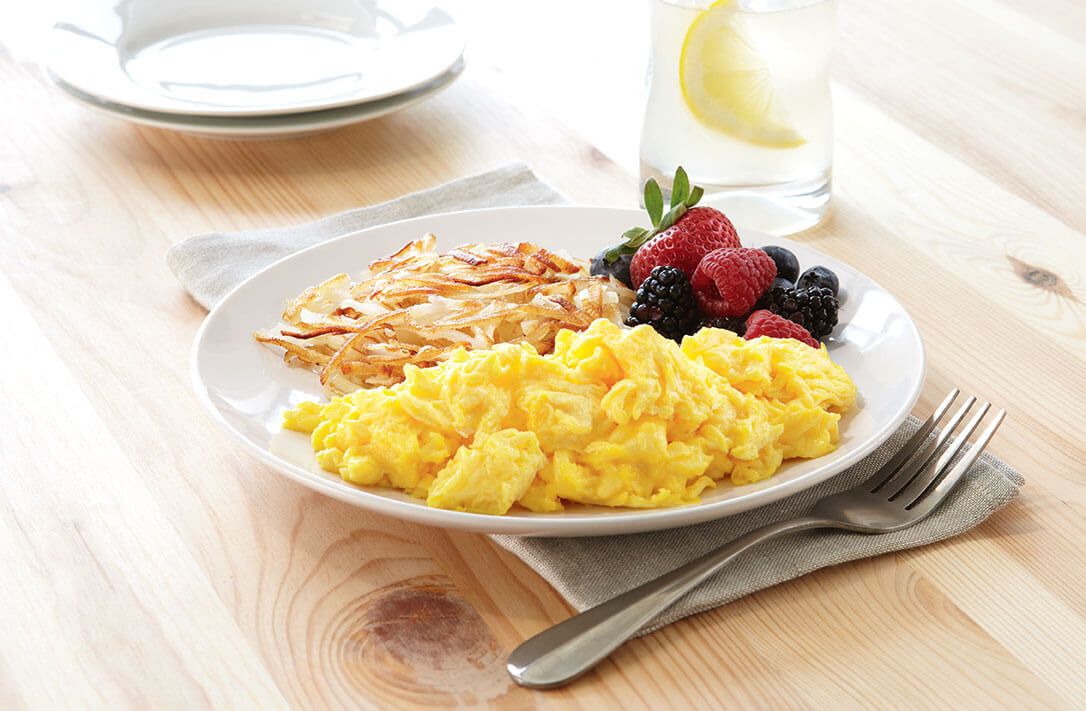
Almost one in 4 consumers procures breakfast from a foodservice operation, reports Technomic (Jul 26, 2022). The breakfast trend is growing this year (Thorn, 2022), who says breakfast “does appear to be Americans’ favorite meal,” as evidenced by customer reviews on popular review websites.
However, breakfast is not just for morning hours; it has shifted to an “all-day affair” (Thorn, 2022). Snacking is on the rise, and the blurring of dayparts continues. Among young Gen Z consumers (ages 20-25) in particular, three meals per day is not the norm for about half (Sloan, 2022).
As for off-premises foodservice, “breakfast is the fastest growing to-go occasion,” reports Foodservice Director magazine (Jun 1, 2022), jumping three times higher over the past year.
About three in 10 consumers are looking for foodservice establishments to add spicier ingredients and flavors to breakfast fare, reports FoodService Director (Jan 18, 2022). Consumers are flocking to value meals at breakfast, too, mentions Technomic (Mar 9, 2022).

Source: USDA, 2022
Many consumers are unaware of potatoes as a source of vitamin C, potassium, and fiber. For example, Potatoes USA (July 27, 2022) notes that one 5.3-oz potato has more potassium than a medium banana.
In addition, a potato provides calcium, magnesium, and folate. (WebMD, 2020). “A potassium rich diet can help decrease blood pressure, protecting the heart and reducing the risk of stroke,” they add.
In addition to these nutrients, potatoes are rich sources of plant-based antioxidants, which minimize cell damage from free radicals and reduce the risk of heart disease and cancer (WebMD). Antioxidants are most concentrated in the skins, they note.
Potatoes and sweet potatoes have similar nutrient profiles, except that sweet potatoes are much higher in vitamin A. As Cleveland Clinic (2022) states it, “Neither spud is a dud.” Take a look at how the two medium-sized potatoes compare:a

Fiber in potatoes can contribute to satiety, while also “keeping cholesterol and blood sugar levels in check,” says WebMD (2020). About half the fiber is in the skin (Cleveland Clinic, 2022). Some potato fiber is in the form of resistant starch, which is a type of fiber that is soluble and fermentable. This type of fiber cannot be broken down by enzymes in the gut, but it can be fermented by beneficial bacteria in the colon.
“Fermentable” means it acts as food for gut bacteria, which makes it a prebiotic—a food that promotes growth of beneficial gut bacteria (Harvard Nutrition Source, 2022). They say that type of fiber “adds bulk to stools but has minimal laxative effect.” Resistant starch can also prevent or treat irritable bowel syndrome and constipation (WebMD, 2020). It may also “help to normalize blood sugar and cholesterol levels (Harvard Nutrition Source). It is estimated that the average American consumes less than 6 gm resistant starch per day (DeMartino et al., 2022).
DeMartino et al. note that “resistant starch has been shown to favorably affect the health of the gut microbiome.” Beneficial gut bacteria produce short-chain fatty acids, such as butyrate, acetate, and propionate. “… These are associated with reductions in risk of cardiometabolic disease, some bowel disorders, and certain cancers,” explain DeMartino et al. Because of this, they note that increasing intake of fermentable carbohydrates is a “key strategy” to improve health. They explain that consuming resistant starch increases healthful butyrate concentrations.
In their research, DeMartino et al. compared the impact of including one potato side dish (2-2.9 gm resistant starch) to participants daily, comparing it with the impact of one refined grain dish. They found that consuming a potato dish daily slightly increased diversity of gut bacteria and led to higher levels of certain bacteria that produce butyrate. Thus, the simple substitution of one serving of potato for refined grain has “measurable impact on the gut microbiota,” they concluded.
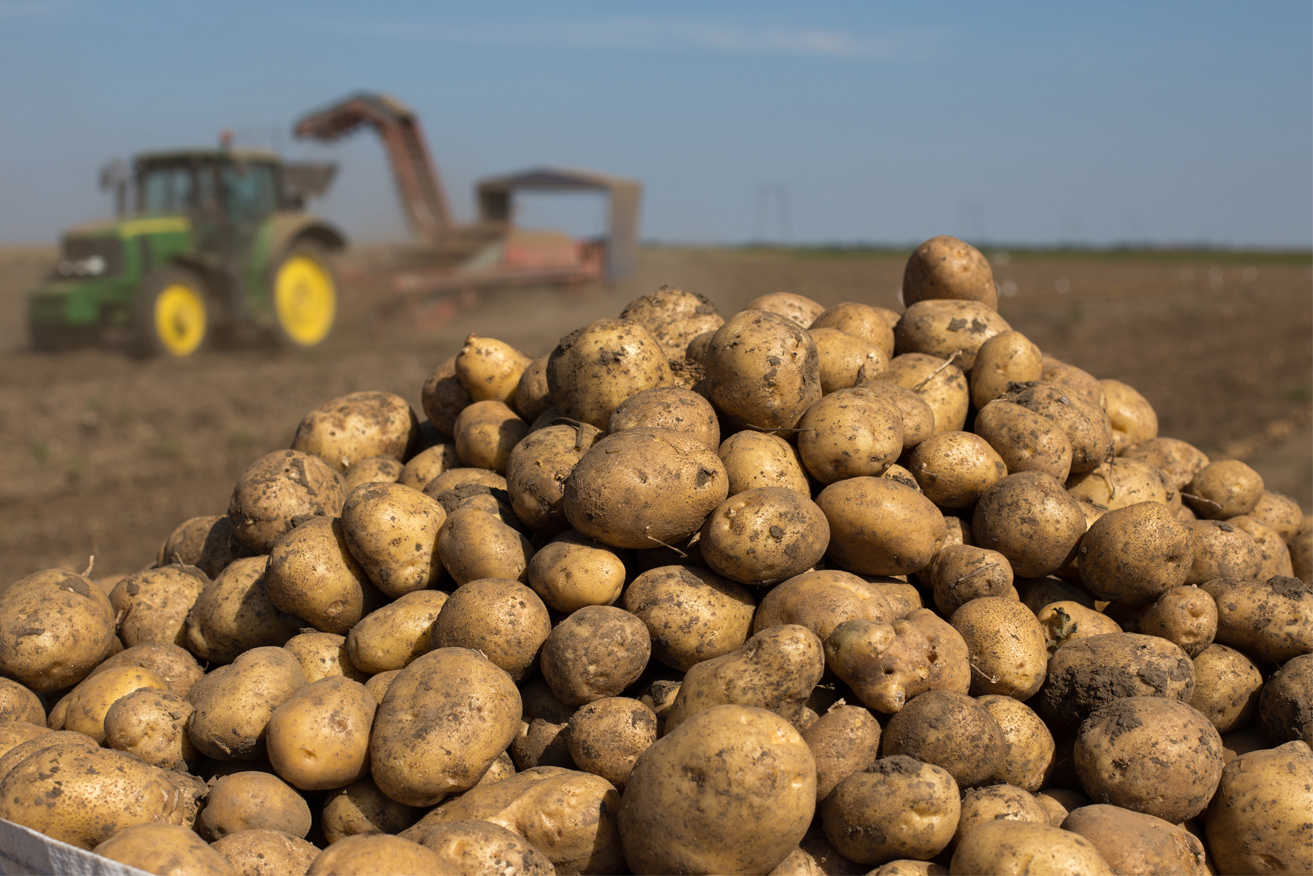
A debate is on regarding this question. How to classify potatoes in nutrition policy guidance is a hot topic today. In the current USDA Dietary Guidelines for Americans 2020-2025, potatoes count as vegetables. Sweet potatoes are in the group of “red and orange vegetables,” and white potatoes are in the group of “starchy vegetables”. There is speculation that the 2026-2030 edition of the Guidelines may move potatoes to the category of grains because they are a starchy food (Brown, Dec. 27, 2023).
The classification question is not about plants or botany, but about the practical applications of dietary guidance.
The USDA myPlate eating plan contained in the Guidelines advises Americans to “make your plate fruits and vegetables” and to “vary your veggies”. Potatoes are indeed nutritious. The concern noted in the Dietary Guidelines is, “Throughout youth, starchy vegetables (e.g., white potatoes, corn)—often in forms that are fried or prepared with additions such as butter and salt—are more frequently consumed than the red and orange; dark green; or beans, peas, and lentils vegetable subgroups.”
Jerold Mande, a nutrition professor at Harvard and former USDA employee, asserts that potatoes are in fact vegetables. He raises a similar point, though: some American diets may disproportionately favor potatoes, reducing intake of a variety of other vegetables (Cho, Jan. 18, 2024). About half of America’s potato supply goes into French fries, Cho reports. Thus, one concern appears to be more about preparation methods than potatoes themselves.
Classification questions have also come up for food-related programs, notes Cho. For example, in 2006, the National Academy of Medicine recommended excluding white potatoes from the WIC program. This idea was not adopted. Limiting potatoes as a vegetable choice has also been discussed in relation to school lunches, adds Cho. Kam Quarles of the National Potato Council, an industry group, noted that a change in overarching dietary guidance would potentially affect all government feeding programs, said Cho. Quarles added that potatoes provide flexibility and a “relatively low cost” for menus.
Katherine Balantekin, a dietitian and assistant professor at the University at Buffalo’s Department of Exercise and Nutrition Sciences, who weighed in for Cho’s article, supported the idea of “eating a wider variety of vegetables”. She also said that “potatoes can be ‘super nutrient dense’ and that the field of nutrition in general has had a problem with ‘vilifying’ foods,” reported Cho.
A Harvard nutritionist, Lilian Cheung, DSc, RD, noted that potatoes can raise blood sugar and that including skins is a good way to gain the benefits of dietary fiber. She commented, “Incorporating potatoes on occasion as part of an overall healthy diet—preferably prepared with the skin intact with minimal added saturated fat—can add enjoyment and satisfaction to a meal” (Brown, Dec. 27, 2023).
Registered Dietitian Felicia Porrazza told CNBC (Onque, Apr. 7, 2023), “Thinking about what a vegetable really is [the “edible portion of a plant”], a potato does fall under that. It’s just a starchy one,” She also noted the ability of potatoes to raise blood sugar, while pointing to the potassium, fiber, vitamin C and vitamin B6 nutrient contributions.
Another Registered Dietitian, Diana Ushay, from New York-Presbyterian Hospital, said she would classify potatoes as a “starchy plant food” and suggested, “we should make space for them in our diet” (Onque, Apr. 7, 2023). She suggested including a green vegetable alongside a potato.
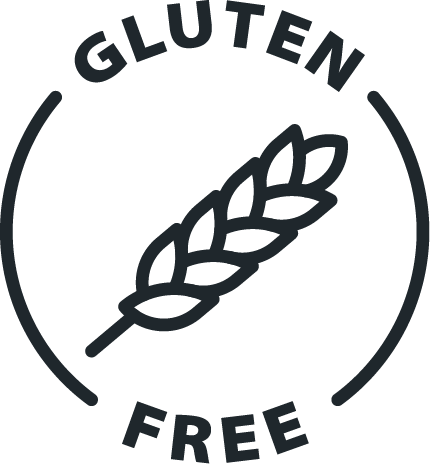
As a gluten-free food, potatoes offer menu versatility for gluten-free dining. About 3 in 10 Americans choose to eat gluten-free. Just over one-third of consumers say they would buy gluten-free products, and the numbers are higher among younger demographics (Stewart, 2021). This figure includes about 1% of the population who has celiac disease, an autoimmune disease that must be managed by strict avoidance of dietary gluten.
Up to 13% of people may have non-celiac gluten or wheat sensitivity, adds Stewart—a “real” condition that is not fully understood. “Symptoms overlap with irritable bowel syndrome and include gastrointestinal discomfort, muscle aches and pains, and rashes, as well as foggy brain— described as an inability to concentrate—fatigue, and headache,” she explains.
Gluten-free eating has captured the interest of consumers far beyond just those who have celiac disease, as “health-conscious consumers are showing increased interest in gluten-free products as a part of a broader healthy eating regime,” according to Srivastava (2021).
A challenge for consumers and food manufacturers alike, though, is nutritional quality of gluten-free ingredients. “Studies show that some gluten-free foods have inferior nutritional profiles compared to their standard counterparts. Following a gluten-free diet may increase the risk of nutritional deficiency, which could ultimately lead to health complications” (Srivastava 2021).
Gluten-free fare in foodservice establishments is predicted to grow 9% over the next five years, says Global Market Insights (2022).
Food Management (2022) underscores the importance of accommodating college and university students who “are following a gluten-free diet out of medical necessity or choice.” Availability of gluten-free dining options are a factor for young people as they choose a school, and 13% of Gen Z (ages 20-25) avoid gluten, reports Food Management.
There is a challenge to sustain adequate variety in gluten-free options, they note. Incorporating naturally gluten-free fruits and vegetables can help. “There is no need for special handling, except to be isolated during the preparation stage from bread, rolls, flour tortillas, flour-based pasta, and other foods that contain gluten.” Preventing cross-contact is an important standard for providing gluten-free menu options, they note.
Potatoes are a whole food that is naturally gluten-free, notes Beyond Celiac (2022). Other examples of gluten-free foods are corn, rice, buckwheat, millet, chickpeas/chickpea flour, and almond flour. The Society for the Study of Celiac (2022) offers gluten-free menu options by meal. Examples using potatoes include:
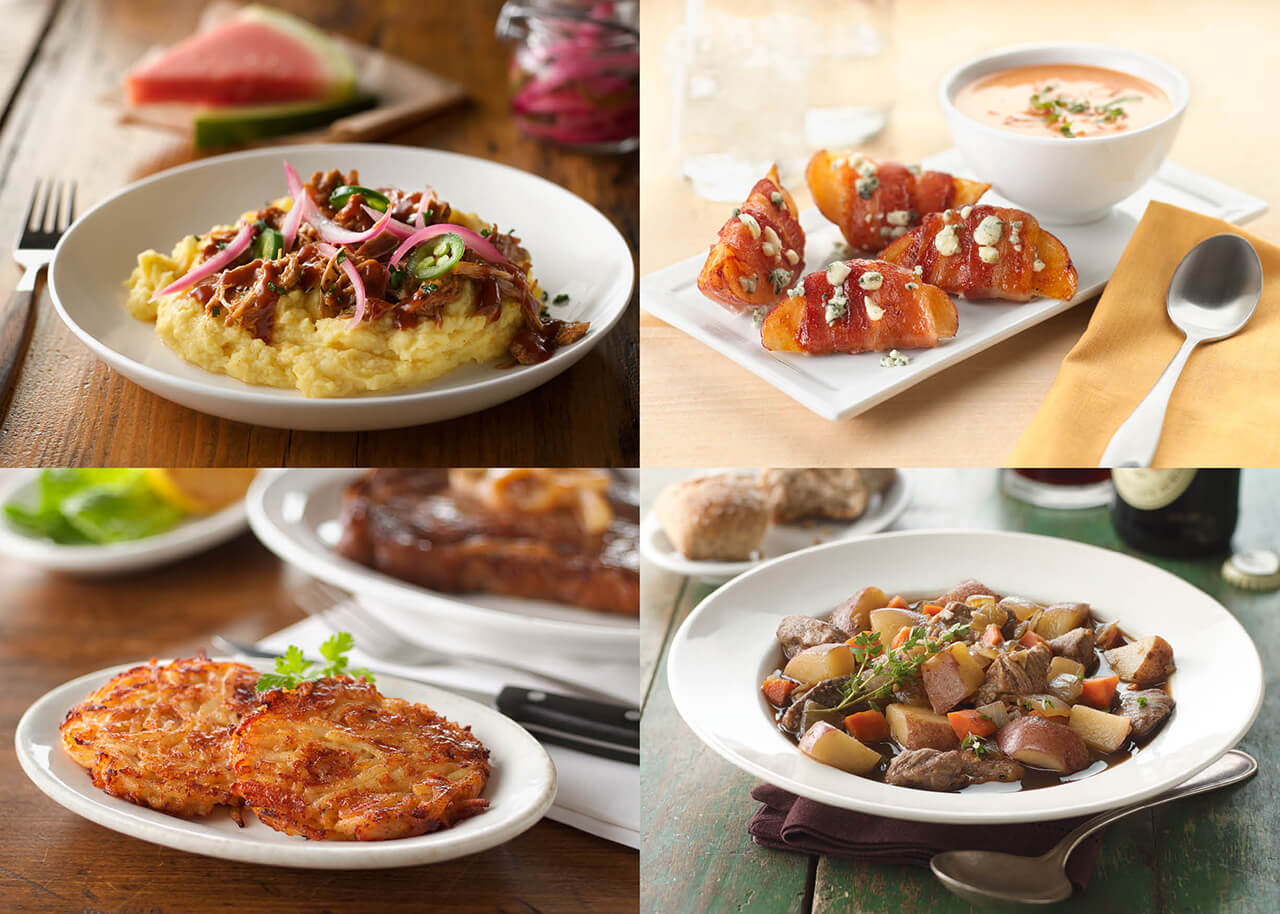
As a recipe ingredient or menu feature, potatoes offer versatility in aligning with a variety of menu trends.
Range of cuisines: Potatoes are used in a variety of cuisines, according to Potatoes USA (2021), such as African, steakhouse, burger, barbeque, Indian, European, Central & South American, Southern, seafood, and American. This makes them a valuable ingredient for a wide variety of flavors. Some of the fast-growing flavors for the breakfast meal (Technomic, 2021) combine well with potatoes, e.g., Gruyere, parsley, paprika, Moroccan, fennel, tarragon, and ricotta.
Off-premises: Implementing grab’n’go menu options is a key strategy for increasing sales across all noncommercial foodservice segments, suggest Mondelez (2022). Factors for success are choosing items that travel well, provide convenience and “craveability,” and support back-of-the-house efficiency. “Potatoes lend themselves perfectly to takeout and off-premise dining occasions, holding their flavor, structure and texture for long periods of time,” observes Potatoes USA (2019, Foodservice Solutions).
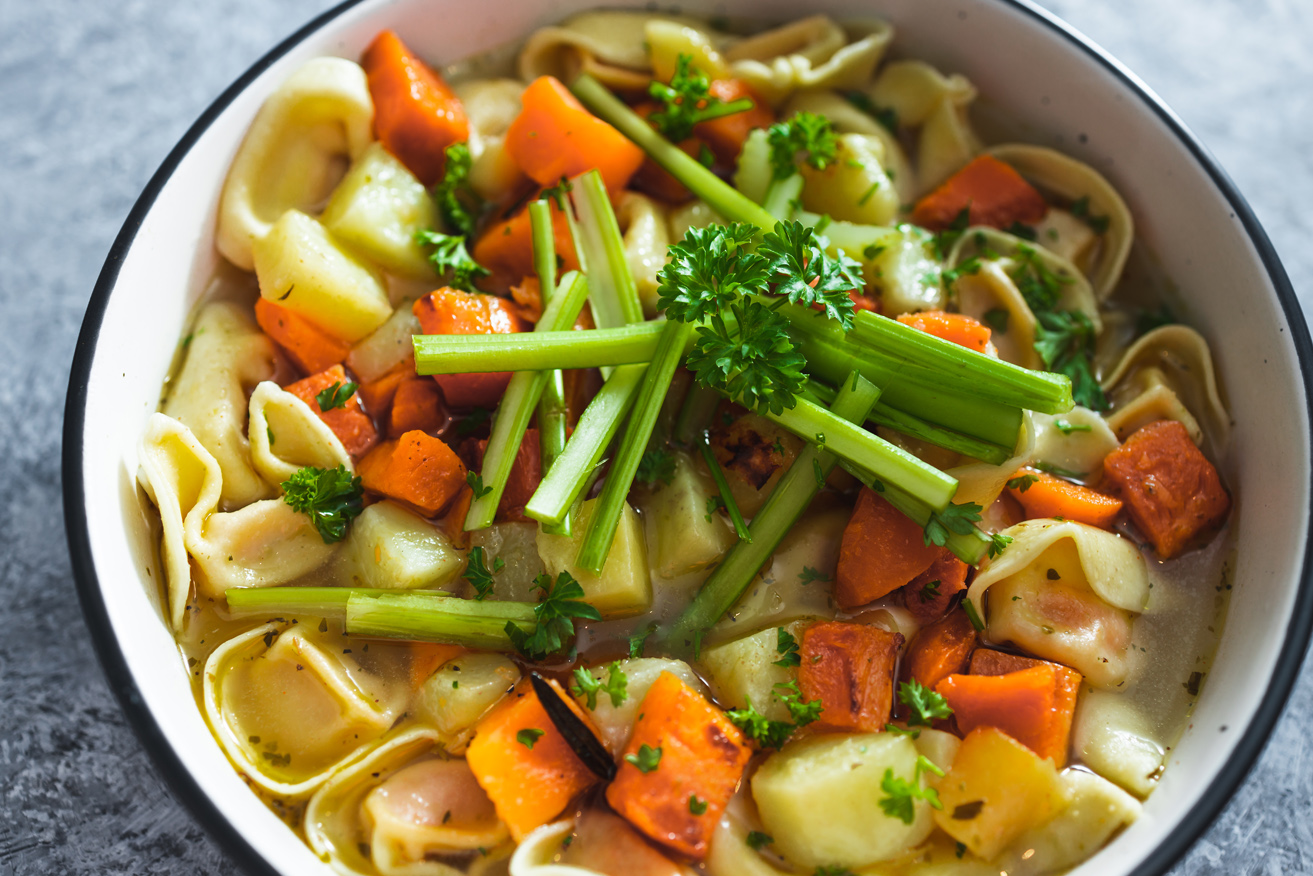
For patrons choosing more plant-based, vegetarian, or vegan menu options, potatoes offer an economical staple ingredient. The International Food Information Council 2022 Food and Health Survey indicated that while only 3% of Americans say they are vegetarian and 2% are vegan, 12% said they are trying to follow a plant-based diet. Potatoes meet other popular food selection criteria identified in the survey, too: “contains fruits or vegetables,” “good source of nutrients,” “good source of fiber.”
Interest in plant-forward eating is growing. The 2023 edition of the Food and Health Survey revealed that 6 out of 10 Americans claim to be following a plant-based, vegetarian, or vegan diet. The top reason for this choice is “to be healthier”. Some also cited concerns for animal welfare or environmental well-being.
The Datassential Plant-Forward Opportunity Report (2023) found that one-quarter of American adults of all ages aim to limit the amount of meat they consume. Most of these individuals do not identify as vegan, vegetarian, or pescatarian (vegetarian plus seafood), but as flexitarian. Like the International Food Information Council, Datassential identified “health” as the key motivator behind this trend. While many young people reported flexitarian or meat-limited diets, the single highest demographic for flexitarians was baby boomers (people born between 1946 and 1964). Datassential further found that overall, just more than half of the general population is “open to a plant-forward eating pattern”.
Registered Dietitian Alyssa Pike (May 17, 2021) defines a flexitarian diet as “a flexible eating style that emphasizes the addition of plant or plant-based foods and beverages, incorporates dairy and eggs and encourages meat to be consumed less frequently and/or in smaller portions.” She adds that the eating plan aligns with the 2020-2025 Dietary Guidelines for Americans, and that it does not set specific goals for calories, protein, carbohydrate, or fat. The eating plan may “may help reduce the risk of cardiovascular disease, diabetes and certain types of cancer, as well as assist with weight management,” according to emerging evidence, she explains. Plant-based eating is also a way to increase intake of dietary fiber, she says. This is important because 95% of Americans do not meet the recommendation of consuming 14 grams of fiber per 1,000 calories. From a sustainability perspective, she notes that plant-based foods generate fewer greenhouse gas emissions, as compared with animal-based foods.
The Datassential report predicts that plant-forward dishes are likely to see more near-term growth than meat analogues. (“Meat analogues” is another term for plant-based meat substitutes designed to provide the sensory experiences of eating meat.) Taste and familiarity are key to successful plant-forward menu options, they add.
Some consumers show rising interest in real plant foods over meat analogues, reports Mintel (Jan. 17, 2023). “Some argue that the term has been co-opted to give a health halo to highly processed foods that may not boast a nutritional advantage outside of being made with non-animal ingredients,” they say. There is strong consumer interest in real plant foods, they add. Food manufacturers are exploring a variety of methodologies to align meat analogues with consumer preferences. Yet, Mintel also advises, ”Don’t lose sight of consumer desire to eat more fruits and vegetables.”
Churchill agrees, saying, “’Plant-based’ is not just about replacing meat and dairy with analogs—it’s about giving plants the central role.” A conclusion from the FoodService Director Menu Directions conference was similar: “there seemed to be a shift away from analogs and toward vegetables as the center of the plate” (FSD Editors, Oct. 10, 2023).
Potatoes adapt well as a center-of-the-plate feature, notes the Idaho Potato Commission (2022), which can be topped with countless variations—eggs, meat, vegetables, cheese, and sauces. For foodservice menu development, a QSR feature describes “potatoes as a plant-based canvas” (Pogacar, Nov. 1, 2022). They can meet requirements for a wide range of cuisines and in multiple formats, such as mashed or shredded, notes the article. Pogacar cites potatoes as a key ingredient in meeting consumers’ choices for flexitarian eating, as well as for accommodating common food sensitivities.
Sweet potatoes combine well with a number of legumes for plant-forward concepts. Cobe (Aug. 22, 2022) cites menu innovations such as a Thai Basil Lentil Burger built on red lentils and sweet potato, a Sweet Potato-Black Bean Bowl with Chimichurri, and hummus that incorporates mashed sweet potatoes. For school foodservice, Coster (Feb. 24, 2024) says it is easy to create plant-forward menus using build-your-own concepts, which hold powerful appeal to kids. She also suggests that for plant-forward menus, it’s worth exploring global cuisines, many of which are plant-forward. When using a vegetable as center-of-the-plate, high-protein add-ons can boost overall protein value. Examples are chickpeas, beans (legumes), nuts, seeds, and cheese. A simple build-your-own concept could be created around potato wedges or diced potatoes.
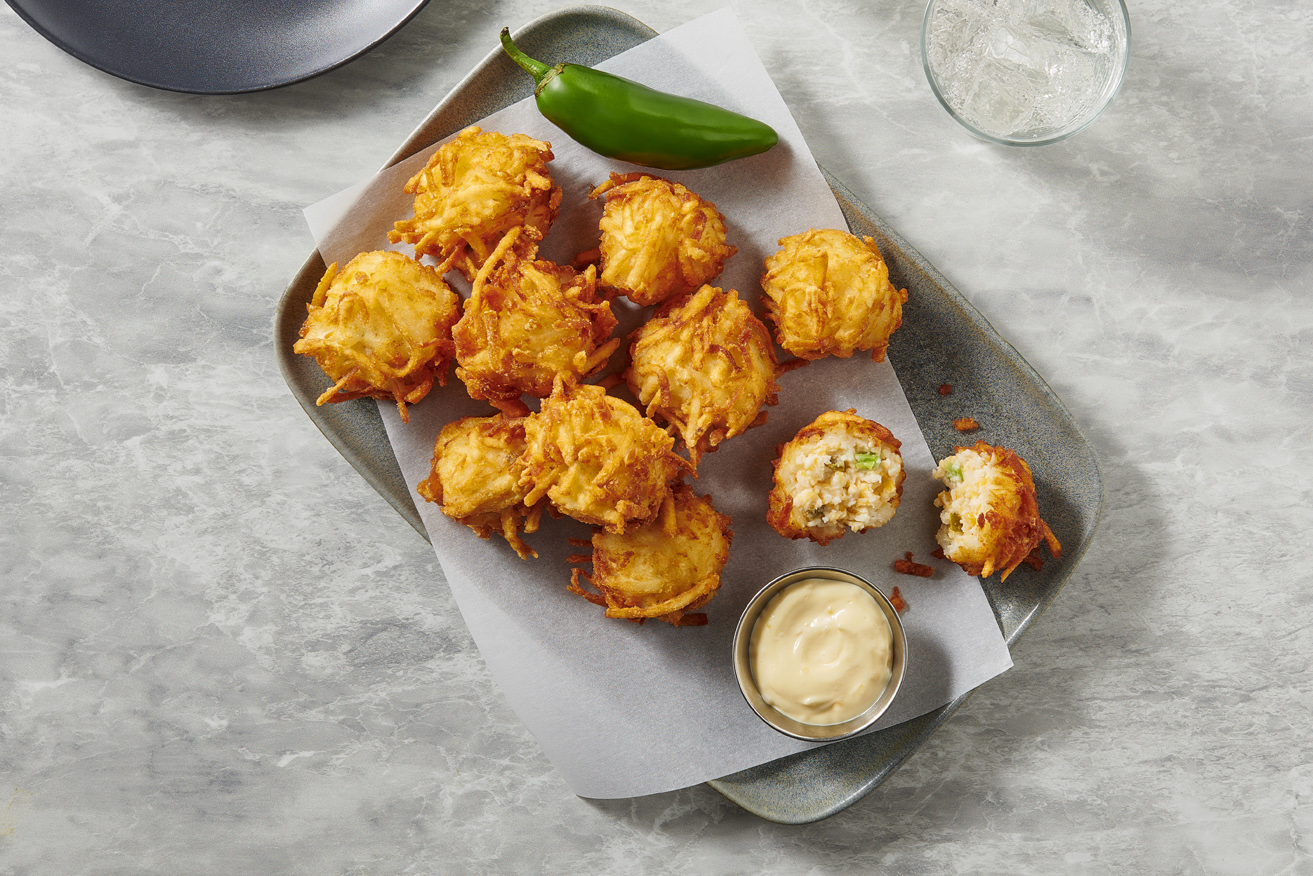
In foodservice, a number of potato dishes are trending, reports Potatoes USA (2021). For fries, trends include Cajun fries (up 66%), waffles fries (up 20%), curly fries (up 4%), and chili cheese fries (up 3%). Outside of fries, they report growth in tater drums [tots], potato bar concepts, smashed potato chili cheese fries, and breakfast potatoes.
“Frozen potatoes can be combined with eggs and veggies and baked in the oven without pre-boiling or par cooking,” suggest Potatoes USA (Potato Goodness, 2022), which minimizes advance prep and makes them labor-efficient in a foodservice environment.
Mashed potatoes: Mashed potatoes form a base for a variety of add-ins to create unique culinary concepts. For example, Potatoes USA (2019) suggests adding vegetables to make pakora (Indian fritters), mixing in crab and other ingredients to make crab cakes, adding ham and cheese, or folding in ricotta cheese to make potato dumplings.
Food Network (2022) recommends potato add-ins such as mixed herbs, roasted garlic, chipotle, or cheeses (cheddar, gruyere, gouda, mozzarella, goat cheese, Parmesan). Toppings work well on mashed potatoes, too. They mention pickled peppers, Kalamata olives, roasted red peppers, parsley, dill, chives, chopped scallions, bacon, sun-dried tomatoes, and shallots.
For mashed sweet potatoes, Food Network cites add-ins like maple syrup and orange zest, or even mashed banana. There is also the “double potato mash,” a blend of mashed white potatoes and mashed sweet potatoes, they say.
Pizza: Potatoes can play a role in the ongoing quest for interesting pizza toppings, according to chef Tony Gemignani Potatoes USA (Potato Goodness, 2022). He comments, “Potatoes are so diverse and versatile, any chef can incorporate them onto multiple styles of fabulous pizzas.”
Salads: Besides working well for chilled or warm potato salads, roasted or steamed potato slices, dices, or wedges are toppers for a variety of green salads. A classic example is Niçoise salad.
Crumbles: Chorizo crumbles make use of leftover tater drums for a plant-based menu ingredient, suggests Potatoes USA (2019, Foodservice Solutions). “Simply crumbled, tossed in Latin American seasonings and baked, it’s the instant star of tacos, soups, salads, dips and garnishes galore.”
Potato carpaccio: Another concept from Potatoes USA (2019, Foodservice Solutions) is potato carpaccio, which combines cooked, diced potatoes with orange, fennel, and a citrus dressing.
Ceviche: “Central American-inspired ceviche is made with traditional ingredients like peppers, radish, avocado and puffed sorghum, but instead of raw fish, we marinate cooked and diced potato cubes in citrus juices,” says Potatoes USA (2019, Foodservice Solutions).
Labor-saving soups: In line with the 2024 What’s Hot Culinary Forecast (National Restaurant Association, 2023), operators can use ready-made mashed potatoes as a labor-saving base for on-trend, comfort-inspiring soups.

Sandwich base: Hash browns can be formed into a sandwich base for a “spudwich,” which can also work well for gluten-free, notes Potatoes USA (Potato Goodness, 2022).
Hash brown flavor twists: In line with the larger trend for new flavors, hash browns are trending not only with traditional salt and pepper, but also with garlic, jalapeno, Thai pepper, and sumac, accompanied by condiments such as ketchup and salsa (Tastewise, 2022). Food Network (2022) recommends flavor twists with added ingredients such as chorizo, or Vidalia onion and Canadian bacon. “The beauty of hash browns is that the dish can be anything from the rustic simplicity of shredded spuds to a dressed-up potato casserole with fresh veggies,” they comment.
Hash brown cups: Fresh or frozen hash browns mixed with an egg or egg whites can be pressed into muffin tins to form cups, suggests the Idaho Potato Commission (2022). “These are then filled with various toppings, from smoked salmon and crème fraiche to an egg, ham, or bacon mixture and baked off.”
Hash brown crust quiche: This is another trending idea that can be made gluten-free and/or vegetarian if desired. An example of a traditional quiche turned hash brown is the quiche Lorraine with Hash Brown Crust (Today, 2022).
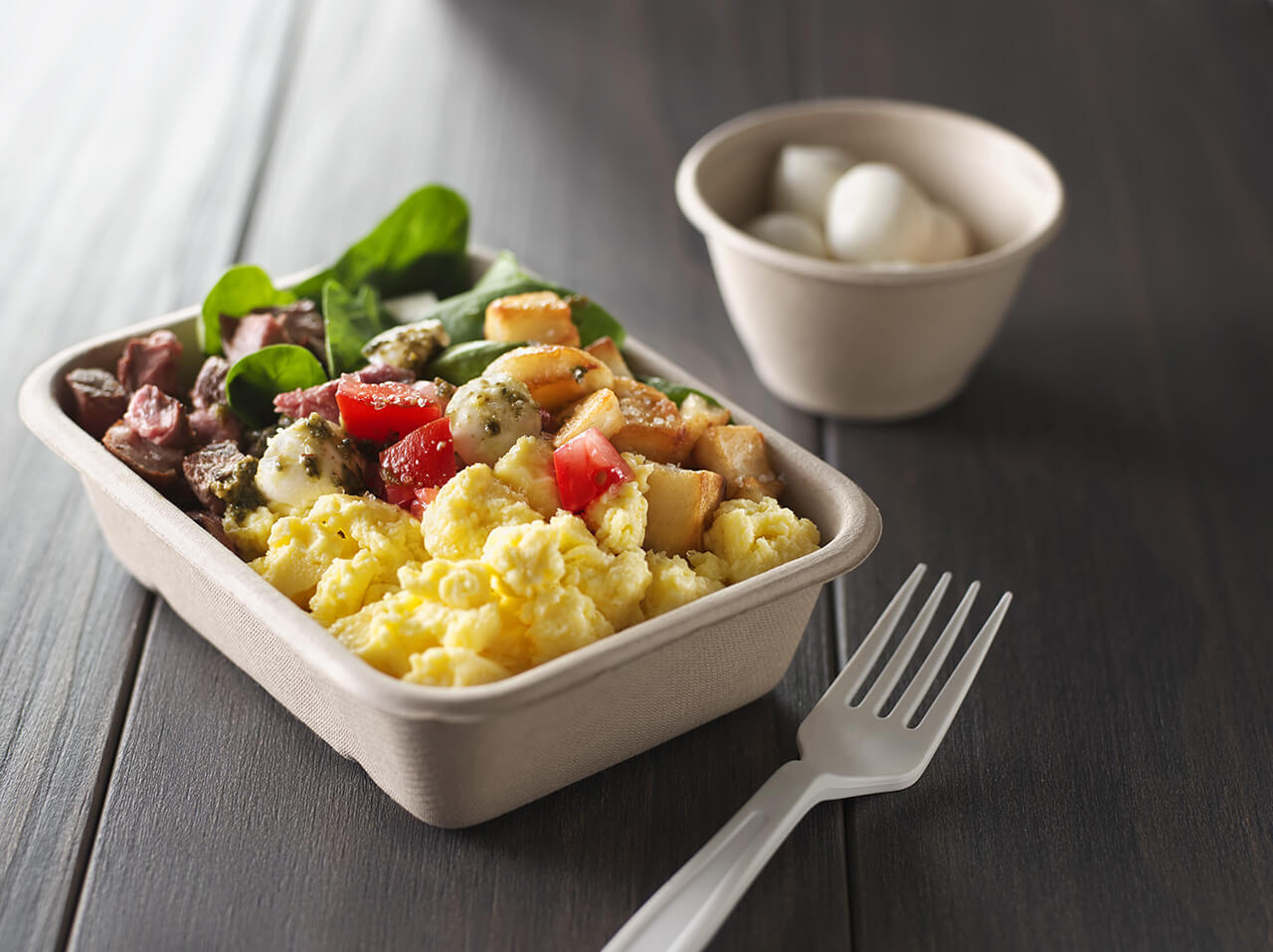
Potatoes are a popular ingredient for food bowls, such as those that combine potato and egg ingredients for a fun and convenient eating experience. Bowls offer endless variations and can be prepared to order, per a customer’s ingredient preferences. They are trending strong and adapt to global condiments, as well as plant-forward ingredients, notes Cobe (2022). The breakfast bowl trend is up more than 6%, she adds.
“Food bowls succeed because they are the confluence of other marketplace trends, namely convenience and personalization. A typical food bowl concept might have four bases, 10 or 15 toppings, three sauces, and four ‘crunch’ options like nuts or seeds—yielding seemingly endless combinations,” Aramark (2019) explains.
“Food bowls shine because of their portability and way of showcasing international flavors: It’s photographable, Instagram-worthy street food at your fingertips,” according to chef Mike Coble (Aramark, 2019). Food bowls also allow customers to sample each ingredient or mix them up, “making their mark” with each ingredient they choose to include. Customers may choose ingredients based on a variety of factors, including a desire for healthful eating or indulgence, they add. This is consistent with the Gen Z food trend, which emphasizes individuality (Sloan, 2022).
“Food bowls are delicious, fun, and portable, with endless possibilities for customization,” according to Lauren Harris-Pincus, MS, RDN (Amidor, 2021). Bowls “can be cost-effective. Individuals can fill bowls with less-expensive ingredients, or combine a variety of inexpensive ingredients with a more expensive food—think smoked salmon in a breakfast bowl with an egg, a mini bagel, and cream cheese. For restaurants and food companies, these types of combinations enable them to charge a reasonable price point for breakfast bowls while still producing a profit,” says Toby Amidor, MS, RD, CDN, FAND (Amidor, 2021). In addition, bowl concepts “can be customized to meet consumers’ special dietary needs. This is especially helpful for foodservice establishments that serve consumers following various dietary patterns. In these settings, food allergies easily can be managed by separating foods and assembling bowls on a line in front of the customer—of course, cross-contact between utensils still would need to be managed,” she says.
A potato base for bowls can be sliced, diced, shredded, or even mashed. KFC, for example, launched a concept called “smash’d potato bowls” in 2024 (Kelso, Jan. 29, 2024).
At Chartwells, a school dining service, chefs are focusing on bowl concepts for K12 students (Gingerella, 2022). One of their trending concepts is a Southwestern bowl featuring turkey chorizo, scrambled eggs, home fries, peppers, onions, cheddar cheese and salsa.
Bowls are an example of a meal that can be made gluten-free and that travels and holds well for off-premises dining. They are popular for breakfast but adapt to snacking or any daypart.

Potatoes are popular with American consumers and incorporate well into a variety of culinary styles. Their nutritional profile makes them a valuable ingredient for healthy eating, as well as a nutritious gluten-free ingredient. As a source of resistant starch, potatoes may offer health benefits by providing prebiotics, along with vitamin C, potassium, and other nutrients.
Potatoes can be useful in accommodating key trends in foodservice, including comfort food, grab’n’go, and plant-forward eating. Foodservice operators can adapt potatoes and potato products to a variety of menu needs to meet the tastes and dietary requirements of their customer populations. They also adapt well to versatile bowl concepts, which can allow customers to express their individuality.
Amidor, T. (Feb 2021). Breakfast Bowls. Today’s Dietitian.
Aramark (2019). Why The Food Bowl Trend Is Here To Stay.
Beyond Celiac. (accessed Jul 28, 2022). Are Potatoes Gluten-Free?
Blake, S. (July 2021). Why the Comeback of Comfort Food Isn’t Slowing Down. FSR.
Brown. S. (Dec. 27, 2023). Do Potatoes Count as a Vegetable? Verywell Health.
Cho, K. (Jan. 18, 2024). Could Potatoes Lose their Status as a Vegetable? The Debate has Deep Roots. The Washington Post.
Churchill, M. (Feb. 21, 2024). Putting Plants at Center Plate. Prepared Foods.
Cleveland Clinic. (Jan. 17, 2022). Potato or Sweet Potato: Which Is Healthier?
Cobe, P. (Aug. 22, 2022). K-12 menus take plant-forward eating back to basics. FoodService Director.
Cobe, P. (accessed Jul 29, 2022). Menus that Move. FoodService Director.
Coster, R. (accessed Feb. 24, 2024). A Guide to Plant-Forward Foodservice. https://healthyschoolrecipes.com/
Datassential. (2023). Plant-Forward Opportunity Report.
DeMartino, P. et al. (Feb. 2022). Additional Resistant Starch from One Potato Side Dish per Day Alters the Gut Microbiota but Not Fecal Short-Chain Fatty Acid Concentrations. Nutrients.
FSD Editors. (Oct. 10, 2023). A taste of 3 culinary trends from top menu innovators. FoodService Director.
Food Management (Jul 21, 2022). Viewpoint: Supporting Gluten-Free Students at Your College Dining Halls.
Food Network (accessed Jul 25, 2022). Best 5 Hash Browns to Bring to the Breakfast Table.
Food Network (accessed Jul 25, 2022). Mix-and-Match Mashed Potatoes.
Food Network (accessed Jul 25, 2022). Must-Try Mashed Potato Recipes.
Foodservice Director (Jun 1, 2022). DoorDash Unveils Consumers’ Favorite Items to Order for Delivery.
Foodservice Director (Jan 18, 2022). What Consumers Want for Breakfast.
Futterman, A (Dec 9, 2021). Top 5 Comfort Foods to Get You Through the Day. Discover Magazine.
Gingerella, B. (Mar 7, 2022). What’s Trending on K12 Breakfast Menus. FoodService Director.
Global Market Insights. (Mar 1, 2022). The Gluten Free Food Market to exceed USD 17.05 billion by 2027.
Harvard Nutrition Source (accessed July 27, 2022). Fiber.
Idaho Potato Commission (accessed Jul 29, 2022). Center of the Plate Potatoes.
International Food Information Council. 2022 Food and Health Survey.
International Food Information Council. 2023 Food & Health Survey.
Kelso, A. KFC Debuts Smash’d Potato Bowles, $20 Combo Meal. Nation’s Restaurant News.
Mintel. (Jan. 17, 2023). Veganuary: The Future of Plant-Based Food and Drink.
Mondelez. (2022). 6 Trends Changing and Challenging the Foodservice Status Quo in 2022.
National Restaurant Association. (Nov 15, 2021). What’s Hot 2022 Culinary Forecast.
National Restaurant Association. (2023). What’s Hot 2024 Culinary Forecast.
Onque, R. (Apr. 7, 2023). Is a Potato a Vegetable? There’s no ‘straightforward answer,’ says nutritionist. CNBC.
Pike, A. (May 17, 2021). What is the flexitarian diet? Food Insight.
Pogacar, C. (Nov. 1, 2022). Potatoes: The Perfect Plant-Based Canvas. QSR magazine.
Potatoes USA (2022). 2022 Consumer Attitudes and Usage.
Potatoes USA (2022). Foodservice Patron Study.
Potatoes USA (2021). Foodservice Potato Menu Trends.
Potatoes USA (2019). Foodservice Solutions Book.
Potatoes USA. (accessed Feb. 24, 2024). Macro Foodservice Industry Trends.
Potatoes USA (accessed July 29, 2022). Potato Goodness.
Potatoes USA (accessed July 27, 2022). Your Guide to Potato Nutrition.
SWNS Digital (Sep 6, 2021). Average American has gained at least six pounds eating these classic comfort foods.
Shoup, ME (Nov 9, 2021). Comfort Food with a Twist. Food Navigator.
Sloan, AE (Mar 1, 2022). Taking the Pulse of Teens and Young Adults. Food Technology Magazine.
The Society for the Study of Celiac (accessed July 28, 2022). Industry Guidelines for GF Foodservice.
Srivastava, N (Nov 24, 2021). 3 Emerging Trends in Gluten-Free Food and Drink. Mintel.
Stewart, KL (Nov 1, 2021). Move Over Bland Gluten-Free Brands. Food Technology Magazine.
Tastewise (accessed Jul 25, 2022). Hash Brown Potatoes Trends, Analytics, and Statistics.
Technomic (2021). Growing Breakfast Flavors.
Technomic (Mar 9, 2022). New State of the Menu report from Technomic spotlights trends to come in 2022.
Technomic (Jul 26, 2022). Technomic reveals global opportunities for breakfast.
Thorn, B. (April 7, 2022). Breakfast returns to restaurants with healthy, spicy and indulgent options. Nation’s Restaurant News.
Today (Apr 22, 2022). Quiche Lorraine with Hash Brown Crust.
USDA. Dietary Guidelines for Americans 2020-2025.
USDA.(accessed Jul 27, 2022). Food Data Central.
WebMD. (Sept. 17, 2020). Health Benefits of Potatoes.
White, A (May 30, 2020). A Brief History of Comfort Food. JSTOR Daily.
Select the correct answer for each question.
1. A concern when a person has a disproportionate amount of potatoes in the diet is:
Select the correct answer for each question.
2. More than half of foodservice operators believe the largest opportunity for potatoes is with:
Select the correct answer for each question.
3. Sweet potatoes are much higher in this nutrient than white potatoes.
Select the correct answer for each question.
4. This potato concept offers convenience and personalization and is consistent with Gen Z food trends.
Course complete!
Your Score: out of 4 correct.
You did it! Click the button below to download your certificate of completion for this course. Keep it for your records. To make it easy on you, we have made the certificate fillable.
Download CertificateDid you like the course you completed? Do you have any feedback or suggestions for future courses? We can’t wait to review your feedback!
Complete Course EvaluationIf you would like to submit your evaluation and comments to the Commission on Dietetic Registration, you may do so at QualityCPE@eatright.org.